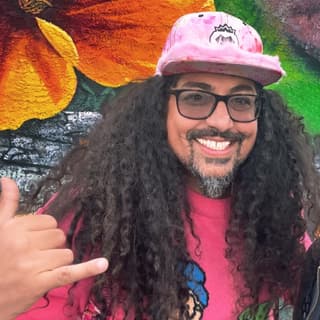
*The views expressed in this article belong to Jeremiah Alexis Verdecias and do not represent the official policy of his employer or any organization.
With generative AI, the challenge for creators is no longer just about making art, it’s about standing out from a rising tide of low-effort “slop.” One answer lies in a hybrid approach that fuses AI’s power with human craftsmanship, taste, and a commitment to quality.
We spoke with Jeremiah Alexis Verdecias, an AI artist and new media specialist who has created content for brands like Red Bull, X/Twitter, and VICE. Now a designer at Amazon Music, Verdecias is also the co-founder of the art and music therapy non-profit, The Goodness Tour. For Verdecias, the conversation around AI extends far beyond corporate applications and into the daily work and future of creators themselves.
- A toolkit for dreamers: "AI is the technology for dreamers who haven’t always been able to create." For Verdecias, this stance is deeply personal. It seemed as if the barrier between an idea and its execution had dramatically lowered. "I've always wanted to have my own comic book since I was a kid. Within three months of discovering this technology, I was able to make one, writing it, designing it, and creating all the characters myself. I never released it, but for me, that was a revelation. Artists now have at their fingertips the ability to manifest their dreams in a way that was never possible."
But Verdecias is not naive about the "doom and gloom" narrative and the legitimate gripes that have split the music industry. He addressed the fear of job displacement directly, reframing it as the latest chapter in technology’s long history of disruption. He pointed to the rise of the internet, which eliminated roles like fax machine repair experts while creating entirely new industries. He believes a key to navigating this change lies in proactive adaptation.
- The new job description: "The job of a demo singer is being phased out. But a former demo singer who learns this technology can now be the one to produce those demos." His solution is the "hybrid creator": an artist who fuses traditional skills with AI tools to elevate their work. This approach, he posits, offers a clear counterpoint to the proliferation of low-effort "AI slop."
Success demands patience, investment, and a deep commitment to craftsmanship and the uniquely human touch that separates a polished piece from a rough draft.
- Slop vs. substance: "I take pride in my work. I bring it into Photoshop to make sure there are five fingers on each hand. That, to me, is the difference between AI slop and an actual AI artist: people who take the time to create something that looks perfect, as if it were done by an artist using traditional digital tools."
- The price of perfection: "The thing about these AI models is you have to stretch them; you can't just go in there thinking one or two suggestions will get you what you want. Sometimes you have to render something eight, nine, or even 15 times to get exactly what you want."
This potential for positive human impact is evident in Verdecias’s non-profit work. He describes a mission with The Goodness Tour to a North Carolina town ravaged by a hurricane, working with at-risk high school students. With the school's Wi-Fi blocking AI tools, he used his phone's hotspot and the AI music generator Suno to help kids who had never written a song before create their own music. The story is a clear example of how AI can serve as a tool for hope, a theme that mirrors other efforts to use AI and music for mental health.
- Hope in a hurricane: "Creating something opens a portal in you. Even if you're going through the worst thing possible, it creates a reason to live. It creates a hope that maybe didn't exist before."
This thoughtful approach extends to the corporate world, where Verdecias described his role as an important check on tech's "move fast and break things" impulse. As major players like Spotify formalize their AI strategies and music labels move closer to new licensing deals, he makes the case for a more cautious framework. He pointed to public backlash against controversial uses of AI, such as the rise of unauthorized fake vocals, as a clear example of the risks. He defined his position as the voice of caution, providing the careful assessment needed to steer a company away from initiatives that could be viewed as unethical or harmful.
- Putting humans first: "As cool as this technology is, if it affects humans in a negative way, it's not serving us. When I first started creating with AI, the default output for a person was a white person. I saw that as an opportunity and took it as a mission to create work featuring marginalized communities, because the more people that utilize AI and feed it diverse data, the better it gets."
That sense of personal responsibility is why he makes a direct appeal to skeptics. He encourages them to actively participate, noting that principled avoidance cedes control of the technology's future. "If you care about these things, you have to be part of the conversation. Don't just leave the room. Then you're going to have no say."
Ultimately, Verdecias’s vision isn't one of replacement, but of evolution. It is being shaped by a new kind of artist who leverages AI as a powerful tool to expand the boundaries of their work, rather than relying on it as a simple crutch. He put forth a direct solution: invest in people. "The hybrid creator is the future. It's someone who combines traditional skills with an AI toolkit to make amazing, next-level content that wouldn't have existed before now."
